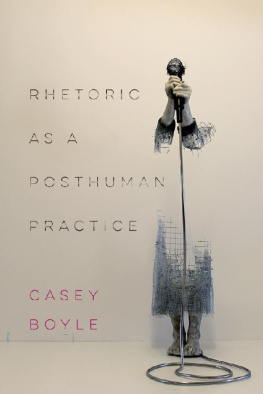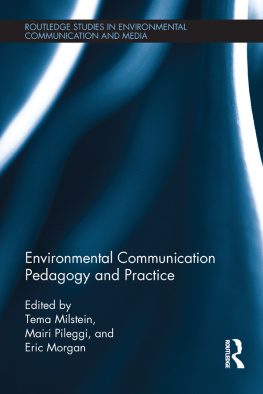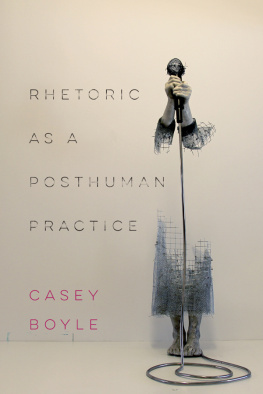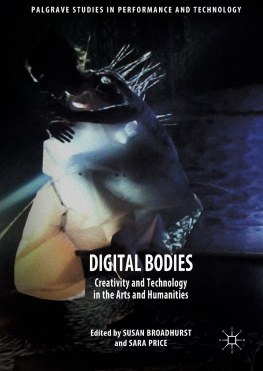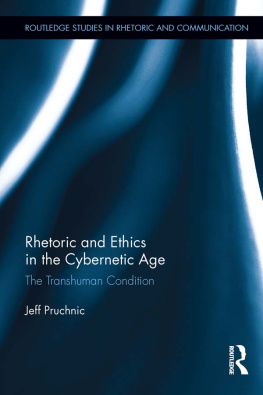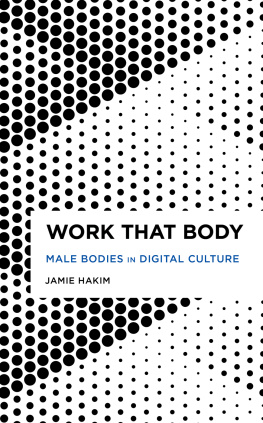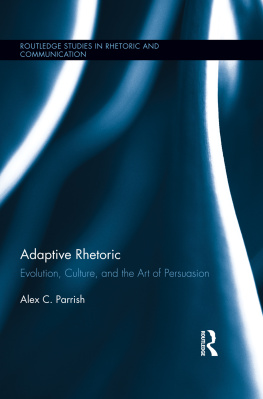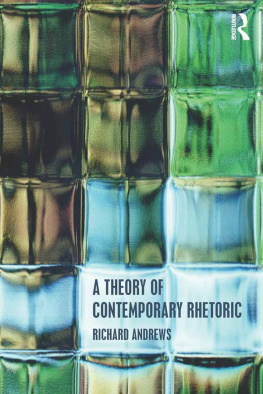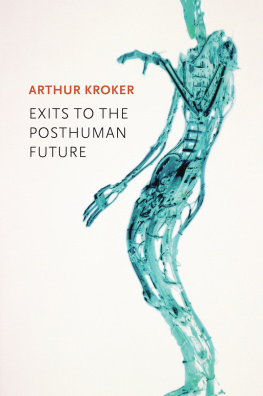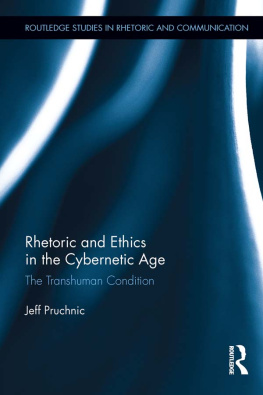RHETORIC AS A POSTHUMAN PRACTICE
RHETORIC
AS A
POSTHUMAN
PRACTICE
CASEY BOYLE

THE OHIO STATE UNIVERSITY PRESS
COLUMBUS
Copyright 2018 by The Ohio State University.
All rights reserved.
Library of Congress Cataloging in Publication Control Number: 2018018817
Chapter five adapted from Homeless Infrastructure in Networked Humanities: From Within and Without the University, edited by Jeff Rice and Brian McNely. 2018 by Parlor Press. Used by permission.
Cover Image, In the Spotlight, by Lene Kilde
Cover design by Christian Fuenfhausen
Text design by Juliet Williams
Type set in Adobe Sabon LT
ISBN: 978-0-8142-7653-2
CONTENTS
PART I
A PREFACE TO PRACTICE
PART II
THEORIZING RHETORICAL PRACTICE
PART III
PRACTICING RHETORICAL THEORY
BLACK AND WHITE FIGURES
COLOR PLATES
It is time to reveal humans as the beings who result from repetition. Just as the nineteenth century stood cognitively under the sign of production and the twentieth under that of reflexivity, the future should present itself under the sign of the exercise.
P ETER S LOTERDIJK , Y OU M UST C HANGE Y OUR L IFE
W hat happens when we ask a rhetorical question? In posing a declarative statement in an interrogative style, a rhetorical question stretches content and form to its extreme limits without separating them into two. While we ask a rhetorical question without expecting an answer from another, we do incite a response. That response takes place by incorporating an audience with a speaker toward resolving a problem. In this sense, the rhetorical question can be understood as analogous to a chemical solution wherein a solute and solvent resolve one into another. A rhetorical question, then, initiates and structures a practice, an exercise, that invents conditions through which its practitioners cultivate shared sensibilities needed to move toward resolution. Any problem worthy of resolution, as we shall repeatedly explore throughout this book, requires practice.
Gilbert Simondon, a French philosopher of technology, poses just such a rhetorical question about practice to his fellow philosopher Jacques Derrida in a letter the former had written but never sent to the latter (On Techno-Aesthetics). Not unlike a traditional rhetor and audience, Simondons unsent letter does not offer communication in a traditional sense as much as it incites a response. As to his question, Simondon wonders about Derridas work, asking, There is no reference to religious thought and practice in your project. Why? We should also take into account aesthetic thought and practice, regardless of whether the latter has a reflexive component (). The letter goes on to consider a version of technological practice not centered on reflection or even instrumental production but, instead, aesthetic sensation. Simondon proposes that aesthetics is not only, nor first and foremost, the sensation of the consumer of the work of art but also, and more originally so, the set of sensations, more or less rich, of the artists themselves (). Responding to what he sees as an unnecessary divide between the technological and the cultural, Simondon posits that there is a continuous spectrum that connects aesthetics to technics (). Techno-aesthetics, then, introduces an ethic as a style of practice wherein boundaries between the human and nonhuman are not framed in instrumentalist or juridical relations but instead as continuous interactions toward the composition of productive ensembles. Toward establishing this style of practice, Simondon offers many examples that demonstrate techno-aesthetics as an open-ended and continuous process by which the technological contributes as much as would the cultural. One of the multiple examples he offers for an ethic based in techno-aesthetics is how the construction of the Eiffel Tower initially served no instrumental purpose but later acquired a function as a radio tower. That example, alongside the other technological developments mentioned in his letter, make it clear for Simondon that contemplation is not techno-aesthetics primary category and that just as important for a technical objects function is an aesthetic sensibility shared between humans and surrounding technical ensembles (). Techno-aesthetics must be understood as an ethic, one cast in an aesthetic-pragmatic register that seeks resonance across form and content, human and nonhuman, the technological and the cultural. Just as the rhetorical question stretches form and content without rupture, so, too, does the kind of practice suggested in Simondons techno-aesthetics exercise form and function toward in-forming relations that resonate. Simondons question is rhetorical, and it is a question concerning practice that should incite rhetorical scholars to join in response. So, what of this problem of practice ? More so , what of the problem of rhetorical practice ?
When we consider practice, two seemingly separate activities often come to mind. The first, at least in scholarly discussions, considers practice to be an approximate grouping of a situated vector of social activity (i.e., Bourdieu; Giddens; de Certeau; Schatzki). Writing is a social practice; medicine is a social practice; food is a social practice; entrepreneurship is a social practice; war is a social practice. It is here that researchers find things in practice to mean the tangible and real as opposed to abstract theoretical wanderings. Thats a fine theory, but will it work in practice ? The other way we think of practice is in the sense of with practice or as exercises through which an individual or a group develops a skill or hones its function to eventually gain some level of mastery (i.e., Ericsson et al.; Schn; Lave and Wenger; Wenger). Athletes practice ball handling; musicians practice instruments; doctors practice medical techniques. Practice, as the common saying goes, makes perfect. In the first, we appeal to concrete particulars to create generalizable knowledge; in the second, we appeal to an abstract ideal to generate practical results. Despite an apparent separation between these two understandings of practice, both are connected in that they rely on a similar relationship between knowing subjects and objects to be known. In these versions of practice, we often resort to instrumentalist orientations that leverage knowledge toward some ideal end for a knowing subject or adhere to processes that reinforce normative social bodies. Put differently, these understandings of practice take for granted a distinct subject or collective body and, thus, a known object and end. Practice for these orientations can be complex, to be sure, but those activities serve to either enhance or maintain a known aim but neither account for what bodies may emerge through practice.
Rhetoric as a Posthuman Practice responds to the questions and propositions above by reframing the terms of practice that accompany the traditional humanist body to become more sensible (sense-able) to the bodies that slip outside of traditional humanist orientations. To foreground what I mean by practice in a rhetorical and posthuman frame: practice is the exercise of tendencies to activate greater capacities. All bodiesa human body, a social network, pollination process, a communication infrastructurebecome bodies by establishing sets of tendencies. These tendenciesbe they commonplaces, networked protocols, cross speciated activity, hardware and software processescan be exercised to create new capacities of interacting with and mediating other bodies. For instance, a body of water in a liquid form has certain tendenciestakes the shape of its container and spreads across surfaces and into a surfaces crevicesthat when exercised (by being put into different relations of being heated up or cooled down) activate new capacities (in gaseous or solid states). Other bodies (a microbe, a human, an institution, a rain forest) also express tendencies that when exercised can develop new capacities of affecting and being affected by the larger ecologies of practice in which those bodies become incorporated. Thus, no body is itself an individual and distinct but is both a part of and a part from multiple arrays of practices.
Next page
